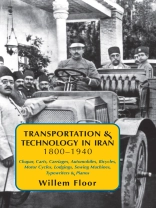Only 100 years ago the main means of transportation in Iran was by quadruped.
Transportation & Technology in Iran, 1800-1940,
by renowned Iranian studies scholar Willem Floor is an in-depth, illustrated, four-part study of the subject. Until the 1920s Iran had no more than 700 kilometers of roads suitable for motor vehicles, which situation greatly impeded Iran’s economic development. Caravans traveled 40 km/day, though travelers in a hurry could cover 150 km/day when using the courier system (
chapar
), which is the subject of part 1. Wheeled transportation, (in part 2 of the books) was rare and limited to only a few parts of country due to the lack of roads. This situation underwent change when carriages became popular in urban areas and on the few modern roads after 1890. Motorized transportation grew in importance after 1921 and really took off in the 1930s, with the construction of a new road network. As a result, newer, more powerful trucks reduced the cost of transportation significantly, thus lowering the cost of retail goods. The increase of motorized transport also meant that car dealers, import rules, mechanics, garages, supply of spare parts, and gasoline distribution as well as traffic regulations had to be created ex nihilo; All these processes are detailed in the book. Like cars, bicycles and motorcycles also were increasingly used as of the 1920s, thus increasing choice in people’s mobility. More road traffic also implied that travelers needed places to spend the night and eat. The change from caravanserais to guest-houses and hotels is discussed in part 3. These changes in transportation methods did not come alone, for other modern tools of change such as the sewing machine and the typewriter also made their appearance and had a major impact on people’s availability and use of time. Finally, the piano made its entry onto the Iranian musical scene, and although not perfectly in tune with the traditional Iranian musical system, it is now as much part of music making in Iran as the
tar
and
santur
(part 4 of the book). All these changes and new technologies did not happen overnight or without problems, and slow adoption initially was limited to the upper-class. However, with falling prices and changing needs and policies these new technologies eventually reached a larger public and the idea that they once were 'exotic’ and 'out of reach’ is now inconceivable to Iranians. The studies in this book provide a new vantage point and understanding of the transfer of modern technology for scholars of the social-economic and cultural history of the Middle East.
Spis treści
Introduction xi
Traditional Modes of Transportation
The Chapar-Khaneh System 3
The Kajaveh and Takht-E Ravan 85
The Use of Carts 93
Modern Modes of Transportation wheeled vehicles
Carriages 103
Automobiles 129
Obstacles to the use of cars 155
Import arrangements 167
Traffic rules and administrative regulations 209
Appendix: Persia, by Augustin W. Ferrin,
American Consul, Tabriz 219
Automotive parts, accessories, and service equipment 221
Bicycles 225
Motorcycles 237
Modern Ways of Lodging Travelers
Hotels in Iran, 1870-1940 243
Tools of Change : The Sewing Machine and the
Typewriter Conquer Iran
The Sewing Machine 297
Typewriters 319
A Short History of the Piano in Iran 329
ILLUSTRATIONS CREDITS 370
BIBLIOGRAPHY 375
index 401
O autorze
Willem Floor studied development economics and non-western sociology, as well as Persian, Arabic and Islamology from 1963-67 at the University of Utrecht (the Netherlands). He received his doctoral degree from the University of Leiden in 1971. Since 1983, Dr. Floor was employed by the World Bank as an energy specialist, however, after his retirement in 2002, he has dedicated his time to the study of the social and political history of Iran, and has published extensively throughout this time. His books include: Public Health in Qajar Iran, Agriculture in Qajar Iran, and The History of Theater in Iran, as well as, The Persian Gulf: A Political and Economic History of 5 Port Cities, 1500-1730, its second volume, Persian Gulf: The Rise of the Gulf Arabs, 1747-1792, third volume, The Rise and Fall of Bandar-e Lengeh, the fourth volume, Bandar Abbas: The Natural Gateway of Southeast Iran, and the fifth volume, The Persian Gulf: Links with the Hinterland Bushehr, Borazjan, Kazerun, Banu Ka’b, & Bandar Abbas, The Persian Gulf: The Hula Arabs of The Shibkuh Coast of Iran, and The Persian Gulf: Dutch-Omani Relations A Commercial & Political History 1651-1806, and The Persian Gulf: Muscat – City, Society and Trade . He has also published, Travels Through Northern Persia, 1770-1774, Titles and Emoluments in Safavid












